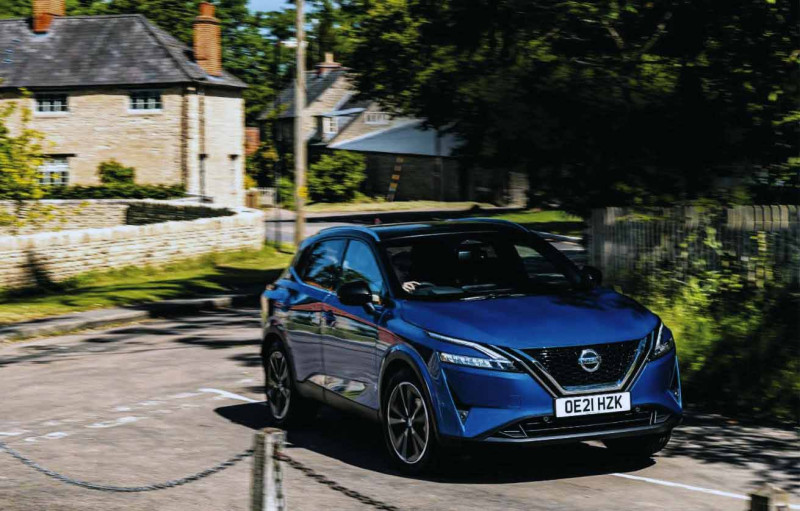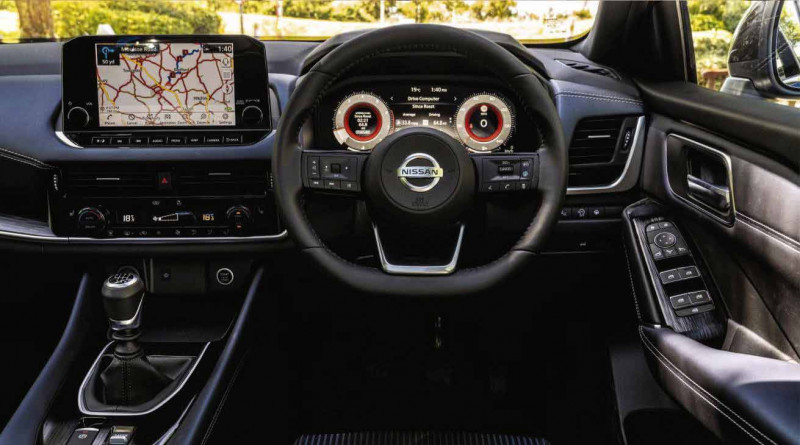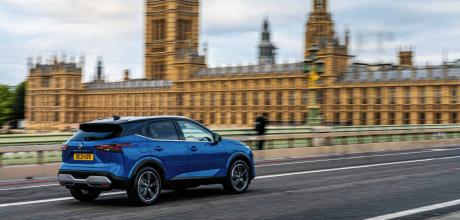2022 Nissan Qashqai 1.3 Tekna
Qashqai: the car that reshaped Britain. The pioneering British-built crossover reborn. Made in Britain, loved by Britons, we take Nissan’s all-new Qashqai to see the people and places that helped it change the automotive world.
KEEP CALM AND QASHQAI ON
London to Sunderland in the latest Nissan Qashqai
Tuesday morning, 6am, and the traffic around London’s Parliament Square is sparse. Serendipitously, an original Nissan Qashqai pulls into the vortex, and to get close I’m going to have to lunge for the fleetingly green traffic light marshalling the next corner.

This third-generation Qashqai runs a 1.3-litre four-pot with mild-hybrid torque boost, and hitting 1900 revs is like firing the start gun of the dad’s race at sports day. Suddenly there’s a fair amount of bulk gaining rapid momentum, and I swing the steering wheel – meatier than you’d expect, obedient off the dead-ahead – and dive into the right-hander. The front end grips, the Qashqai leans through the corner then settles quickly, and we can carry on after our quarry. It’s clear that this all-new Qashqai is dynamically sharper than its predecessors. All 3.5 million of them.
One of the architects of the Qashqai’s success is Matthew Weaver, these days the vice-president for Nissan Design Europe. Back in 2003 he was a senior designer recently relocated to the Rotunda, a ’60s concrete building, formerly a British Rail depot, that had been transformed from graffiti-covered dereliction into Nissan’s London design centre.
Nissan’s then-CEO Carlos Ghosn had just cancelled the replacement for the Almera hatchback, fearing it would be a loss-making also-ran against the VW Golf and Ford Focus. But if not another hatch, what should replace it? The engineering, design, product planning and market intelligence teams were sent away to figure it out.
‘Within a very short space of time, we got a new, raised platform, for a vehicle we thought there was a need for in Europe,’ recalls Weaver. The concept mixed an SUV’s higher vantage point and Nissan’s serious 4x4 heritage in the Patrol and Pathfinder with the footprint of a mid-size hatchback, and dynamics and efficiency closer to a hatch’s too.

‘My manager, Makoto Yamane, described it as car-up not SUV-down. Even though there hadn’t been that kind of vehicle before, you could picture that really easily. Sometimes the simple things are genius.’
The crossover was born. And we’re standing in the circular room where the original 2004 concept, and its three subsequent production designs, were milled from clay. ‘The hands in this building, many of them did the first one. And even the building has influenced the car.’ Weaver gestures at the walls which hide graffiti with listed status; its reddy-orange hue influenced the concept car’s trim.
Overhead, traffic is flowing in and out of London on the Westway, Qashqais no doubt among their number. ‘There are so many on the road, it’s almost like social architecture,’ sums up the design chief. His team’s new exterior design is clearly Qashqai, but with slimline lamps, chiselled surfaces and big wheels pushed out to the corners. It’s a handsome thing, especially in Magnetic Blue metallic with contrasting black roof.
We head north out of London. The CMF-C platform is all-new, and while the stiffer bodyshell weighs 60kg less thanks to aluminium sections and lighter joining techniques, the Mk3 as a whole is heavier. That’s down to new technologies including a mild-hybrid system (though Nissan chose a 12- not 48-volt battery to save weight and cost) and 2-3cm more length, width and height, together boosting interior space.
Jousting with Porsche Cayennes and BMW X5s on some grand Hampstead streets, the Qashqai’s raised seat gives a decent view and the quicker steering – assisted by an electric motor now adjacent to the rack – helps me jink between parked cars. The six-speed manual isn’t the slickest, though: throwing second to third feels a little long, the clutch is a bit arthritic and the hybrid’s supplementary torque doesn’t offset some lag at low revs. The smooth, responsive and stepped Xtronic CVT is better.
As we leave the capital, coarse tarmac generates a grumbling undertone from the Continental EcoContact 6 tyres, and persistent rustles of wind can affect the windscreen and sides. Our destination is Nissan’s Technical Centre Europe, outside Cranfield in Bedfordshire, responsible for the engineering of all three generations. It’s a nondescript industrial building fronted by some ponds spanned by Japanese-style arched wooden bridges.
Inside, the secured workshops resemble one of 007’s walks through a bustling Q branch, with cars accelerating and braking on dynos to test emissions, a Qashqai dancing on a hydraulic jig to simulate five years/37,000 miles of punishment in just three weeks, while on the fringes zebra-clad prototypes glide in and out.
This is David Moss’s playground. Moss, Nissan Europe’s R&D chief, is the engineer who kicked off Qashqai 3, but he also served as interior cockpit manager on the first Qashqai. ‘In the early days, we could see we were doing something different, and of course you dare to dream. But you don’t know if it’s going to take off.’
Initial production – at Nissan Manufacturing UK near Sunderland – was pegged at just over 100,000 cars a year. ‘It was a single model on a multi-model line. But before we knew it, it was 200,000 cars, then 300,000. Now it’s a case of one model [dominating] two lines.’
And is Nissan Cranfield a critical hub in the Qashqai story? ‘Absolutely,’ Moss asserts. ‘You can’t engineer a vehicle for Europe and be successful if you’re not in Europe. And [British roads] are the toughest test for dynamic performance: drive to Milton Keynes station from here, across the country lanes, which can be off-camber, broken tarmac, through the roundabouts. Add some Germany v-max driving and Europe offers the hardest driving you can find.’
Time to put that to the test, heading cross-country to the A1. There’s an underlying tautness to the ride, and in corners the nose grips as doggedly to its line as an old lag to an alibi. This Tekna car rides on 19-inch rims, mounted on a torsion beam rear axle (cars with 20-inch wheels, and all-wheel drive versions, get a multi-link rear). It feels well-planted, dealing calmly with mid-corner shocks, the body control recovered quickly after rolling or pitching.
Cruising through villages, then tailing a red Mk1, there’s time to reflect on the reason for the Qashqai’s success. In 2007, it landed right at the spaghetti junction of human needs: a car to make the family feel safe and comfortable, to look a bit different (but not too different), to make loading the kids and hauling luggage easier, all at a reasonable price.
But also at an environmental cost. The industry’s unanimous plunge into bigger, heavier crossovers has stalled progress on cutting carbon emissions. It will take a widespread shift to electric to get things back on track.
Early next year, Nissan will launch an E-Power Qashqai, the most electrified version yet. The petrol engine will act as a generator to charge a 2kWh battery, in turn powering a 188bhp electric motor. One-pedal driving will introduce the Qashqai base to e-motoring – but insulated from charging infrastructure challenges. That’s true to the customer-focused Qashqai ethos of trying to make life easier. The vast boot can be segmented with reversible boards to stop grocery bags flying everywhere, or provide a wipe-clean surface for muddy wellies.
The rear doors open to nearly 90˚. There’s plentiful rear legroom and headroom. And this second-highest-grade model also has Nissan’s ProPilot assisted drive, steering and controlling vehicle speed on the motorway, a reassuring back-up if you find yourself distracted by the kids.
The pilgrimage ends at sprawling Nissan Sunderland, the UK’s biggest single-site car plant, employing 6000 workers directly. Panels are pressed, engines assembled, bodies-in-white painted, all feeding the two assembly lines that churn out one Qashqai every minute.
And here’s the final statistic that sums up the industry- changing influence of Nissan’s crossover: since 2007, one in every five cars built in the UK has been a Qashqai. ‘It’s astonishing,’ says Alan Johnson, the plant director. ‘The Qashqai has had a huge impact not just on the north-east, but on UK car manufacturing as a whole.’ And its influence spreads way beyond, exported to more than 100 countries. The Qashqai may not excite car enthusiasts. But by giving the public what they didn’t know they truly needed, a team of Britons helped change the automotive world.
SINCE 2007, ONE IN EVERY FIVE CARS BUILT IN THE UK HAS BEEN A QASHQAI
- 2022 Nissan Qashqai 1.3 Tekna
- PRICE £31,565
- POWERTRAIN 1332cc 16v turbocharged four-cylinder, mild hybrid, six-speed manual, front-wheel drive
- PERFORMANCE 156bhp @ 5500rpm, 192lb ft @ 1800rpm,
- 9.5sec 0-62mph, 128mph
- EFFICIENCY 44.1mpg, 145g/km CO2
- WEIGHT 1385-1435kg
- ON SALE Now
- 3/5
Easy to forget how radical the Qashqai once was. There are Qashqais everywhere, along with its many imitators
MAT WEAVER
European design chief ‘There are so many, it’s like social architecture’
DAVE MOSS
European R&D chief ‘We saw we were doing something different’
ALAN JOHNSON
Sunderland plant MD ‘All that’s good about UK manufacturing’
THIS NEW QASHQAI IS DYNAMICALLY SHARPER THAN ITS PREDECE S SORS ,ALL 3.5 MILLION OF THEM
Tekna-spec test car well kitted, and hasn’t ditched useful physical controls. Quashqai Mk3 may not be Nissan’s finest hour, but does the job fine Roomier inside; sunshine not guaranteed Nissan Qashqai: as British as red telephone boxes


